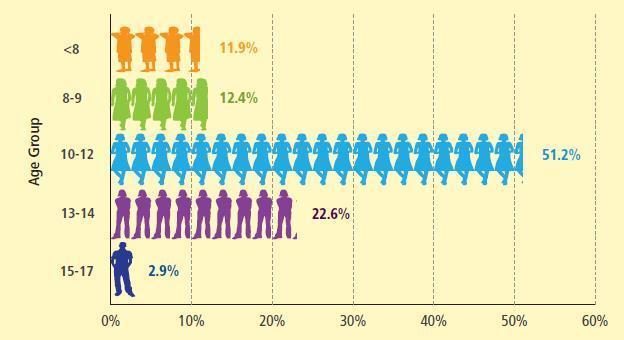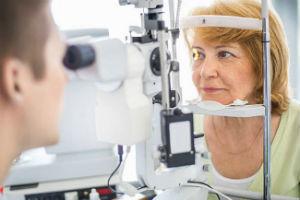What role do children and teens play in your practice?
97% of optometrists currently fit contact lenses on patients under 18 years of age according to a recent survey conducted by the American Optometric Association Research and Information Center.[1] In fact, 4 million children under the age of 18 are currently wearing soft contact lenses in the United States.[2] While this suggests nearly all optometrists agree that teens can be successfully fit with contact lenses, opinions about the appropriate age to start children in contact lens wear vary widely. As can be seen in Figure 1 below, the majority of optometrists agree that the ages of 10-12 is an appropriate time to introduce children to contact lens wear. However, 1 in 4 optometrists think soft contact lenses should be introduced from age 13 onward, while nearly 1 in 4 optometrists advocate fitting children 9 years of age or younger with soft contact lenses. A recent review of past clinical studies suggests that contact lens wear can be appropriate for children across this entire age range. The review found that the risk of eye inflammation and infection in children is no higher than in adults, and in the youngest age range of 8 to 11 years, it may be even lower.[3]
What wearing modality is best for children?
The AOA survey found that the majority of children under 12 were fit in 1 day disposable lenses.1 Interestingly, the survey found that older children were fit in reusable lenses more often than 1 day lenses.1 This is surprising as numerous studies have found 1 day lenses to have a much lower incidence of corneal infiltrative events[4] and that wearers of 1 day lenses are much more compliant with replacement schedules[5]. Furthermore, 1 day lenses have been promoted for younger wearers due to the greater ease of maintaining compliance as lens cases, solutions, and proper lens cleaning etiquette are taken out of the equation with these lenses that are replaced on a daily basis.[6]
While cost was listed as a barrier to fitting children in 1 day disposable contact lenses, recent estimates have suggested that 1 day lenses are only marginally more expensive than monthly or two weekly lenses, particularly when accounting for solution and lens case costs.[7] CooperVision® has a broad portfolio of 1 day lenses including hydrogel and silicone hydrogel options to fulfill the needs of most young wearers including astigmats, hyperopes and myopes. With competitive pricing for our clariti® 1 day silicone hydrogel lenses, cost doesn’t need to be a reason to avoid fitting the most convenient lens modality for children and teens, 1 day disposable contact lenses.
Figure 1. ECPs Opinions on Appropriate Age to Introduce Soft Contact Lenses from Reference 1.

What about the benefits of contact lens wear for children?
A research group from The Ohio State University developed the Pediatric Refractive Error Profile (PREP), a pediatric quality-of-life survey.[8] These subjects were then refitted into contact lenses and the study concluded that contact lenses significantly improved the quality of life, as reported by children and teens using the PREP, and there was not a difference in improvement between children and teens. The study also found that contact lens wear dramatically improves how children and teens feel about their appearance and participation in activities, leading to greater satisfaction with their refractive error correction. The authors concluded that the improvement in quality of life after contact lens wear indicates that children should be offered contact lenses as a treatment for refractive error as routinely as teens.
What about chair time associated with fitting young children?
Doesn’t it take a lot longer to fit pre-teens in contact lenses compared to teenagers and young adults?
In another study, contact lenses in pediatrics or CLIP, the Ohio State team looked at chair time and ocular health differences in pre-teens and teenagers.[9] They found that there were no significant differences in ocular health measures between pre-teens and teenagers fitted in contact lenses. They did find that chair time with fitting younger children was about 15 minutes longer than teens, but that the majority of this increased fitting time was training on insertion and removal of contact lenses, a task that can be performed by contact lens fitting staff. With this taken into account they found that the ECPs time with the patient was no different between children and teens. They also found that neither children nor teens experienced problems related to contact lens wear during the study. This study led the authors to conclude that eye care practitioners should consider routinely offering contact lenses as a treatment option, even for children 8 years old.
The available evidence from the literature suggests that the evaluated risks of wearing contact lenses are no greater in children than in adults, but that the benefits may be numerous. Fitting children in contact lenses can offer you the opportunity to expand your contact lens practice. 1 day lenses can be a good option for children and teens due to increased ease of use and compliance. CooperVision is here to help with a vast 1 day contact lens portfolio. For more information on our 1 day contact lens portfolio talk to your CooperVision sales representative or research our 1 day lenses at https://coopervision.com/practitioner/our-products. For more tips on how to start the 1 day conversation with patients, go to https://coopervision.com/practitioner/clinical-resources/moving-frequent-replacement-contact-lens-wearers-1-day-lenses.
[3] Bullimore MA. The Safety of Soft Contact Lenses in Children. Optometry and Vision Science, Vol. 94, No. 6, June 2017.
[4] A) Chalmers RL, Hickson-Curran SB, Keay L, Gleason WJ, Albright R. Rates of adverse events with hydrogel and silicone hydrogel daily disposable lenses in a large postmarket surveillance registry: the TEMPO Registry. Invest Ophthalmol Vis Sci. 2015 Jan 8;56:654-663. B)Stapleton F, Keay L, Edwards K, et al. The incidence of contact lens-related microbial keratitis in Australia. Ophthalmology. 2008 Oct;115:1655-1662. C) Chalmers RL, Keay L, McNally J, Kern J. Multicenter case‐control study of the role of lens materials and care products on the development of corneal infiltrates. Optom Vision Sci 2012; 89: 316–325.
[5] Review of Cornea and Contact Lenses, March 2006.
[8] Walline, J.J. et.al. Eye Contact Lens. 2007 Nov;33(6 Pt 1):317-21.
[9] Walline, J.J. et. al. Optom Vis Sci. 2007 Sep;84(9):896-902.








